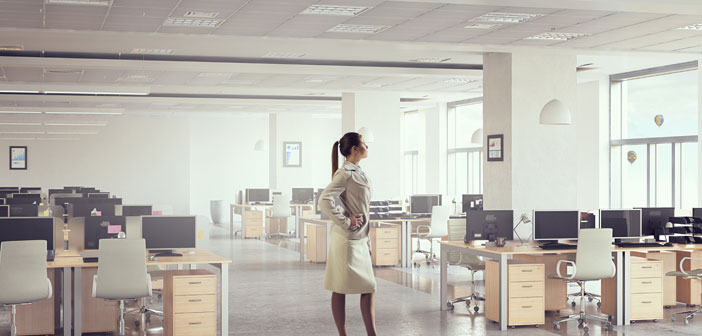When you think about happiness in the workplace, what factors come to mind? Compensation and benefits? Company culture? Managers and peers? While these are all important factors, there is growing attention given to how workplace environments contribute (or detract from) employee happiness.
With Americans spending 40+ hours in the office every week (more than half of our waking hours), it’s critical that we pay attention to the physical space that we work in.
A new survey conducted by Kelton Global sheds some light on how physical surroundings influence the happiness levels of employed Americans in the workplace. The study, which looked at 560 employed Americans ages 18 and older, provides some practical information that can help your company become a better place to work.
Nearly all respondents (92 percent) said there was some aspect of their current work environment that causes some unhappiness. Of those, nearly two-thirds said having a cluttered work area is the main reason for that unhappiness. That was followed closely by outdated technology at 61 percent and an uncomfortable workstation at 54 percent.
Fortunately, some of the most-cited areas of unhappiness are easily remedied. Take for example the number one culprit for office discomfort—the office chair. Nearly half of respondents said the type of office chair they have is critical to their happiness at work. Many companies standardize on one chair throughout the office. That’s great if all employees are the same size, carry out the same functions and have the same physical needs. However, that’s likely not the case.
Take some time to understand what your employees need in an office chair. Is it a chair with ergonomic adjustments and ample support? Is it a chair that can accommodate big and tall users—or conversely, shorter chairs that accommodate petite users? Starting with the right chair will go a long way in creating a better environment for your team.
Privacy is another concern that came up often with 43 percent of respondents stating that the lack of having a private space in which to work negatively impacts them. This issue has grown over the years as companies raced to tear down the cubicle farms and replaced them with “open-concept” workstations.
The benefit of these open workspaces is greater collaboration, more attractive sightlines and the removal of the “cube” mentality—the feeling that employees were literally boxed in. However, the move to wide-open spaces also removed the sense of privacy and a space conducive for heads-down work.
To remedy the overcorrection, it’s easy to add privacy panels to the tops of desks or even add privacy screens to separate areas of the office. Giving employees a way to break away from the rest of the group will provide a significant boost to morale and workplace health.
Even the layout or design of the office can have a major impact on workplace happiness. Respondents said that productivity, motivation, anxiety and quality of work were all impacted by the layout of the office itself. As with privacy, the key to having an attractive office environment is in providing flexibility and various layouts for different types of work.
Many offices have started adding couches and plush seating to create welcoming areas for teams to collaborate instead of using stoic conference rooms. Companies also have been paying more attention to their breakrooms and cafés. Simply adding some modern tables and chairs can transform a boring lunchroom into an energetic and invigorating space.
Finally, a key revelation from the study is that younger employees, in general, feel stronger about these issues than older employees. In other words, addressing these influencing factors of happiness is important for attracting and retaining the largest segment of the U.S. workforce: millennials.
By taking some time to address these simple improvements to your office environment, you’ll create a workspace that promotes employee happiness which in turn will help your organization reach new heights.
Dean Stier is chief marketing officer at National Business Furniture.




